The cryptocurrency market cap has surged to $4 trillion. Where is the money coming from? Can the upward trend be sustained? This article dissects the undercurrents of funding and the secrets behind the rise.
Written by: Tanay Ved
Translated by: Saoirse, Foresight News
Key Points:
- Bitcoin has achieved a market cap exceeding $1 trillion, reflecting that as the total cryptocurrency market cap approaches $4 trillion, long-term holders are investing more funds and their confidence is stronger.
- Continuous inflows into spot ETFs, coupled with increasing corporate cash reserves, have led to demand for BTC and ETH exceeding new issuance.
- The market's dominant landscape is gradually broadening, with ETH strengthening relatively, while altcoins like SOL and XRP are also seeing increased participation due to rising spot trading volumes.
- The "GENIUS Act" has established the first federal regulatory framework in the U.S. for fiat-backed stablecoins, bringing regulatory clarity to the over $250 billion stablecoin market and laying the foundation for increased industry participation and competitiveness.
Introduction
The digital asset market is nearing the significant milestone of $4 trillion, marking an important development in the industry. This latest surge is driven by a combination of structural and cyclical factors, including sustained inflows into Bitcoin and Ethereum spot ETFs, accelerated accumulation by digital asset fund management companies, and major regulatory breakthroughs such as the passage of the "GENIUS Act." The driving force behind cryptocurrencies seems to be gaining momentum.
In this article, we will analyze the key market forces and on-chain capital flows that are propelling this expansion phase.
Bitcoin Achieves $1 Trillion Market Cap, Market Activity Broadens
Bitcoin has reached an all-time high of $123,000, with a market cap rising to $2.38 trillion, and its "realized market cap" has surpassed $1 trillion. This data indicates that as prices remain high, capital inflows are becoming more profound, highlighting Bitcoin's increasingly recognized status as a global asset amid strong ETF demand and heightened institutional interest.
(Note: Realized market cap is calculated based on the price at which each token last moved on-chain, providing a more accurate reflection of actual capital inflows and asset accumulation by market participants. This metric better represents the confidence of long-term holders and the true valuation level of the market compared to regular market cap, which is calculated at current prices.)
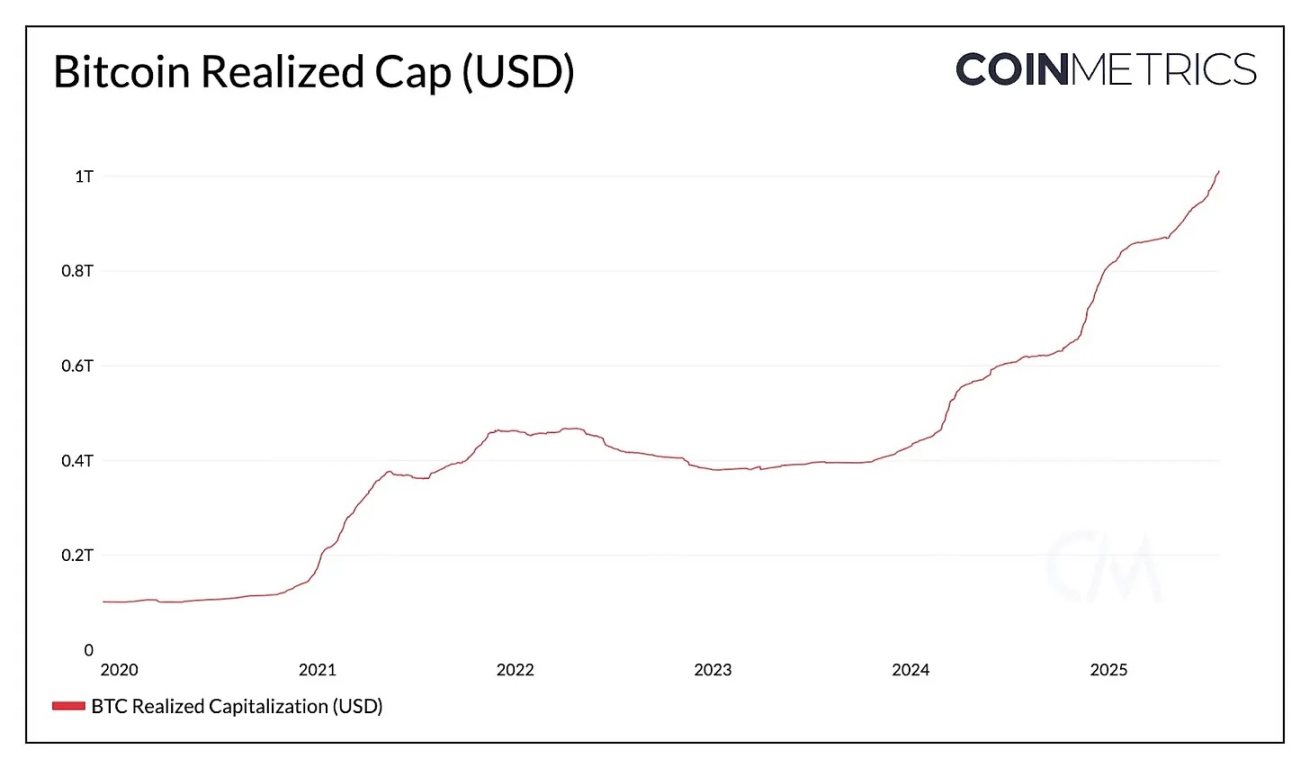
_Source: _Coin Metrics Network Data Pro
Recent market dynamics suggest that we may be in the early stages of broadening the market's dominant landscape. Ethereum has begun to show relative strength, with the ETH/BTC exchange rate rebounding 73% since May, and ETH prices surpassing $3,900. This momentum is attributed to record ETF inflows, increased corporate cash reserve adoption, and Ethereum's continued dominance in the stablecoin space, making it a beneficiary of the "GENIUS Act."
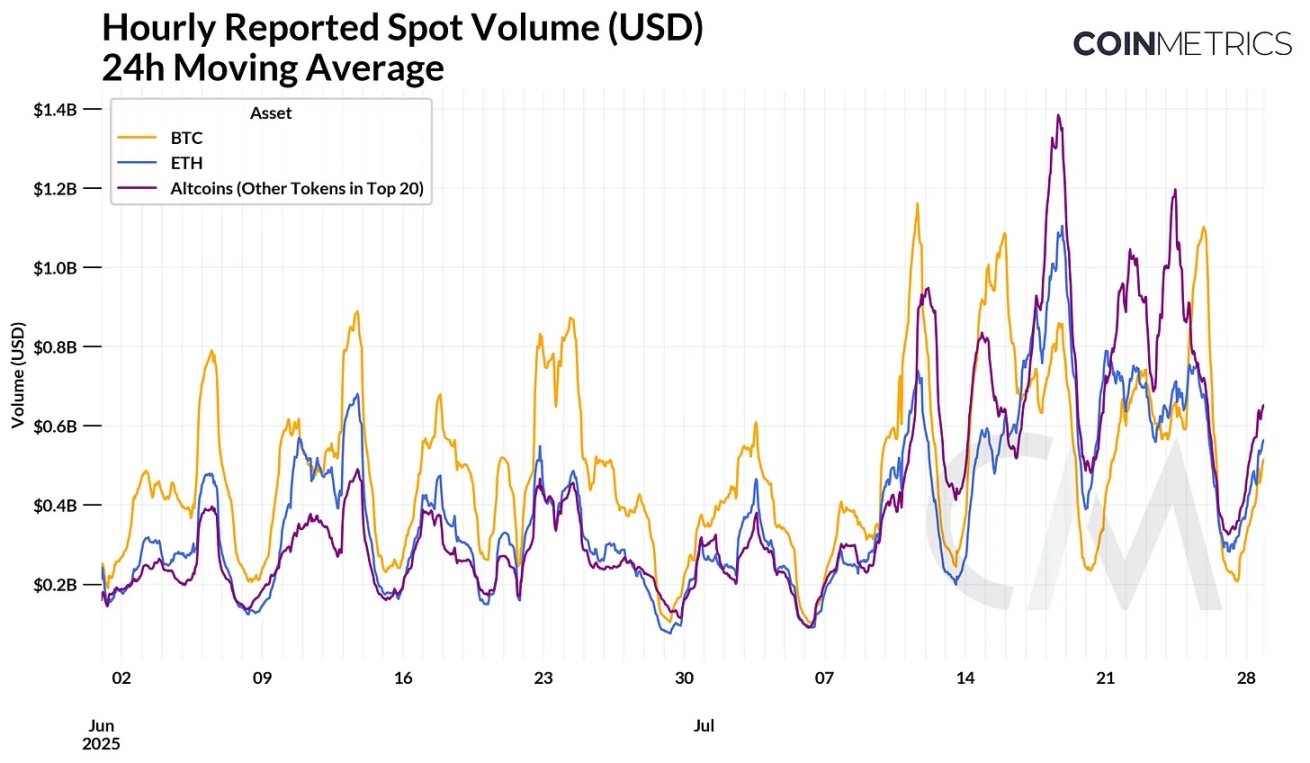
Source: Coin Metrics Market Data Pro
This broadening landscape is also reflected in spot trading volumes, with trading activity for ETH and major altcoins like SOL and XRP reviving. While Bitcoin trading volumes remain strong, ETH and altcoin trading volumes have seen significant growth in recent weeks. As the total market cap of altcoins approaches $1.6 trillion, Bitcoin's market dominance has dropped to 59%. Although initial signs of a broadening landscape have emerged, whether this indicates a sustained market shift remains to be seen.
The table below summarizes market data for the top 20 tokens by market cap (excluding stablecoins and other on-chain derivatives):
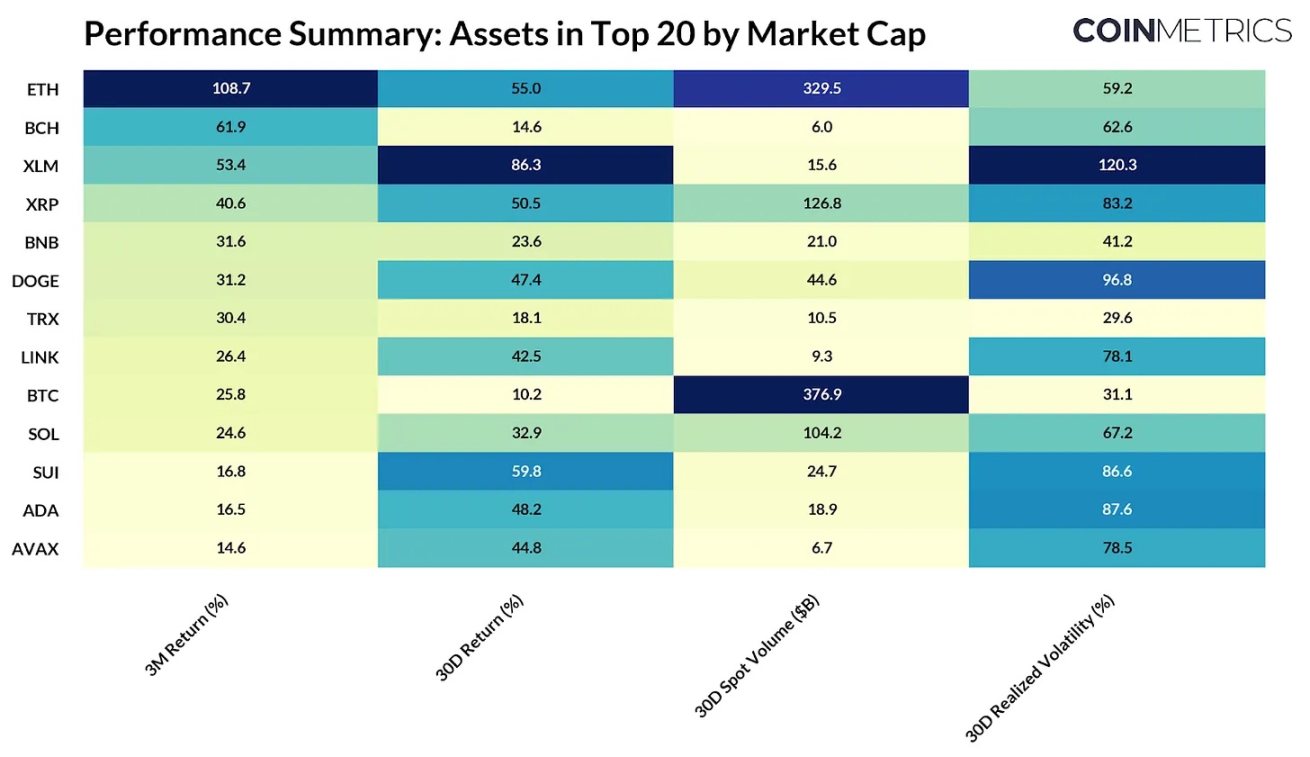
Source: Coin Metrics Reference Rates&Market Data Pro
ETF and Corporate Cash Reserves Drive Accelerated Demand Growth
A significant source of demand for Bitcoin and Ethereum comes from spot ETFs. After a slowdown in March and April, Bitcoin ETF inflows regained momentum in May, bringing the total holdings of U.S. spot ETFs to over 1.27 million BTC (6.4% of total supply). BlackRock's iShares Bitcoin Trust (IBIT) remains the largest issuer, with holdings of 735,000 BTC (valued at $87 billion).
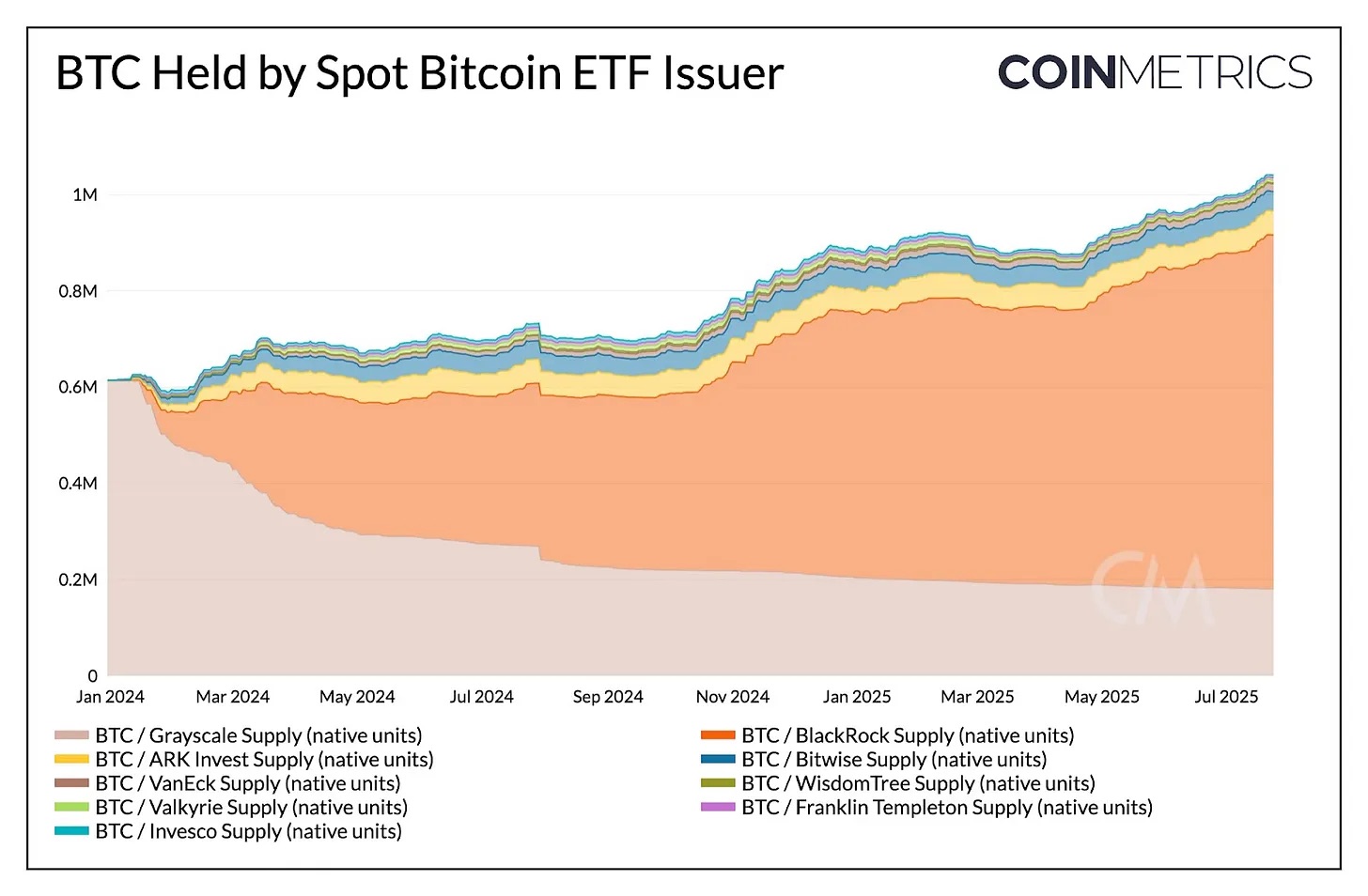
_Source: _Coin Metrics Network Data Pro, Note: Excludes Fidelity's Wise Origin Bitcoin Fund (FBTC)
Ethereum is currently experiencing a similar surge in demand. In recent weeks, Ethereum spot ETFs have seen consecutive net inflows, sometimes even surpassing Bitcoin ETFs. Although Ethereum ETFs have been available for over a year, growth has been significant in recent months, with total ETH held by ETFs reaching 5.8 million, accounting for 4.8% of total supply.
An increasing number of corporate cash reserves focused on Ethereum are also supporting demand growth, leading to ETH accumulation exceeding new issuance. Unlike Bitcoin cash reserves, which primarily hold BTC as a passive asset, ETH cash reserves actively generate native yields through staking and DeFi, a model that has now extended to other major token ecosystems like Solana (SOL), TRON (TRX), and Ethena (ENA).
On-chain Holdings by Address Balance
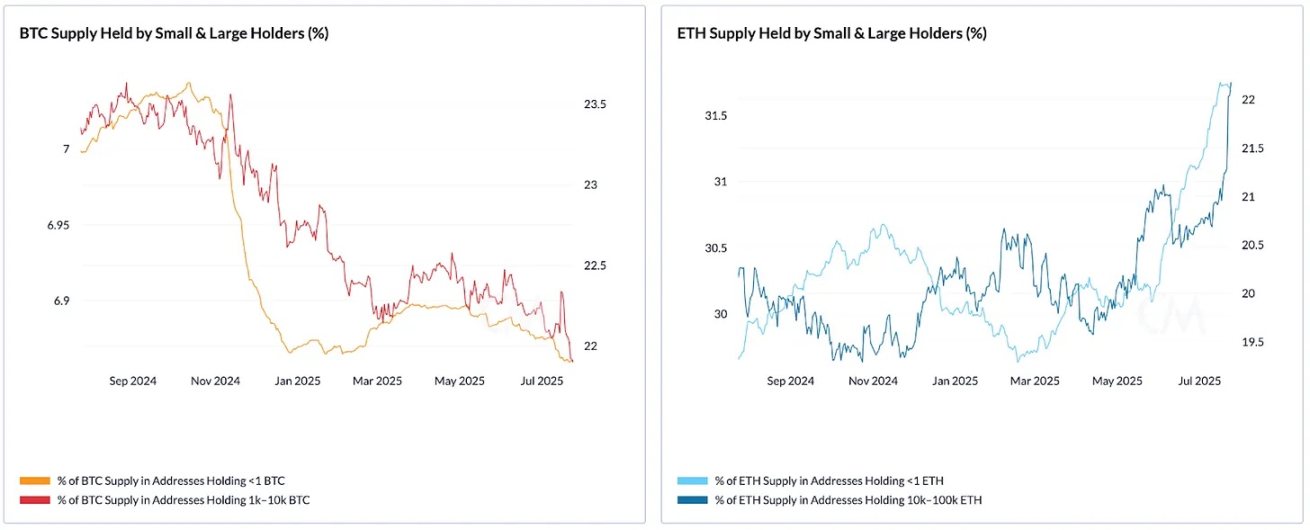
_Source: _Coin Metrics Network Data Pro(BTC and ETH supply by address balance)
From the chart above, it can be seen that over the past year, the holdings of small (1 BTC) and large (1k–10k BTC) Bitcoin holders have gradually decreased, indicating that the market has entered a period of chip dispersion as prices remain high. In contrast, Ethereum shows new accumulation signs, especially among large holders (10k–100k ETH), whose holdings have recently risen to over 22%. Small ETH holders (1 ETH) have also increased their holdings, continuing a steady upward trend that began in 2021.
The "GENIUS Act" and a New Era for Stablecoins
On July 18, the "GENIUS Act" was officially signed into law, establishing the first federal framework in the U.S. for fiat-backed stablecoins. This framework creates a fair competitive environment for stablecoin issuers, requiring them to maintain full reserves composed of low-risk, short-term U.S. Treasury securities and cash, undergo regular audits, and obtain issuance licenses. Similar to the approval of Bitcoin spot ETFs, the "GENIUS Act" is expected to bring clarity and legitimacy to the stablecoin space dominated by dollar-pegged stablecoins.
From the 30-day rolling supply changes, it can be observed that stablecoin supply has accelerated in recent weeks, with total supply now exceeding $255 billion.
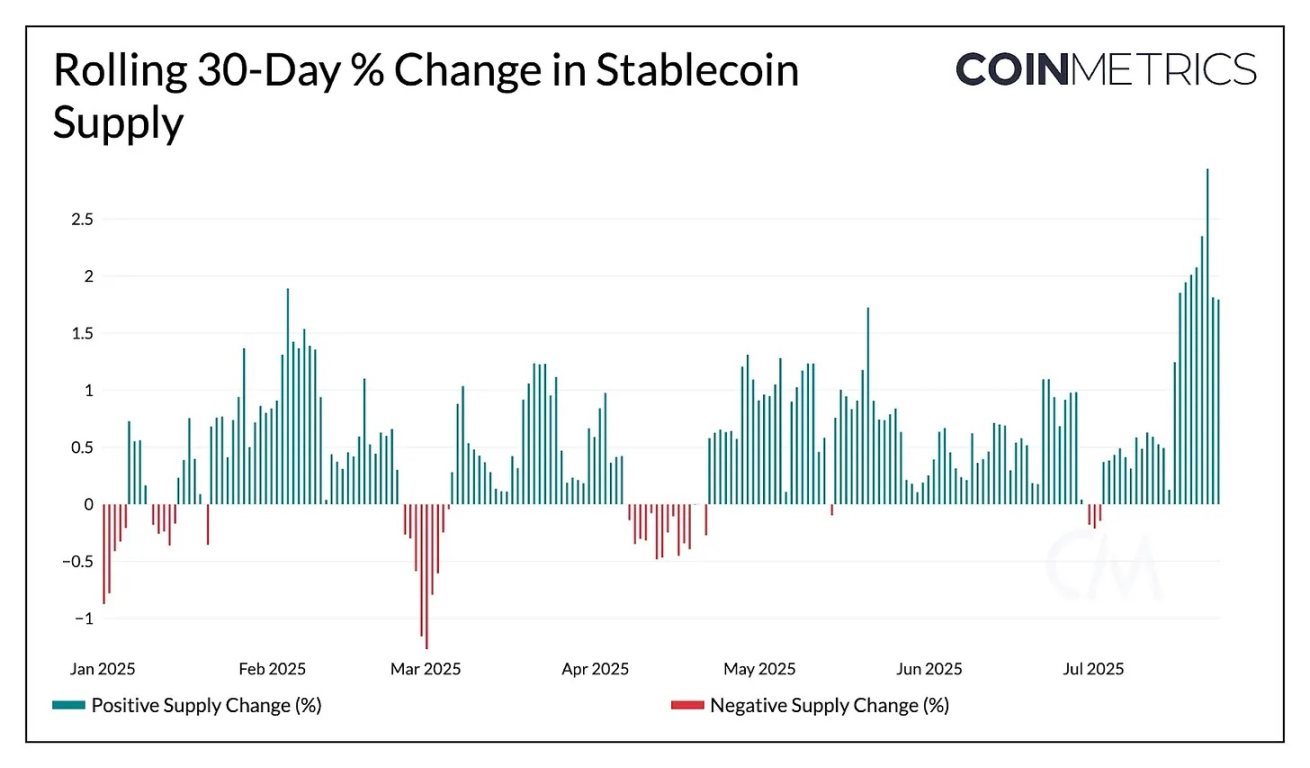
_Source: _Coin Metrics Network Data Pro
This framework is expected to enhance market trust in fiat-backed stablecoins, lower the barriers for new entrants, and create conditions for competitive upgrades in the payment sector. From existing issuers like Tether and Circle to potential entrants such as regulated banks and fintech companies, competition could not only lower costs for consumers and businesses but also enhance demand for the dollar.
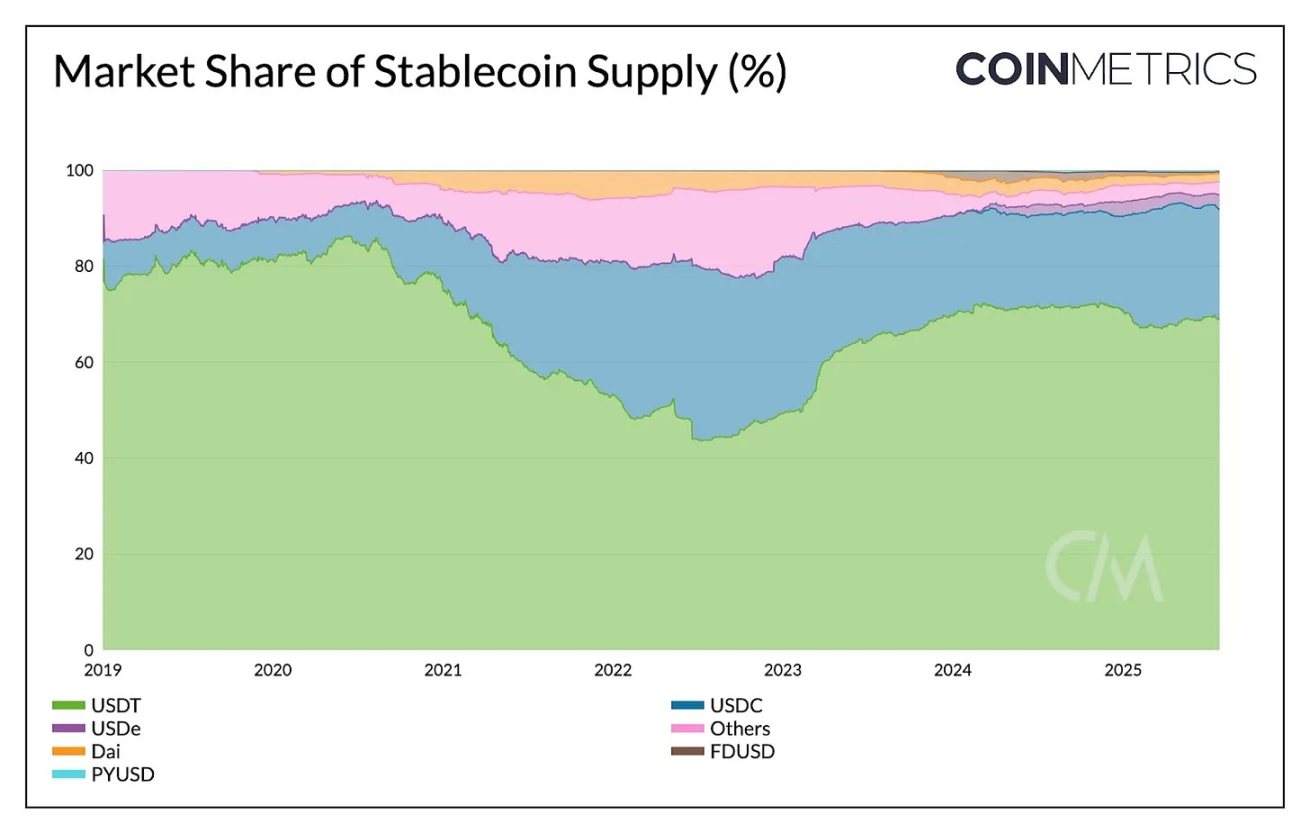
_Source: _Coin Metrics Network Data Pro
Among existing issuers, Circle and Paxos appear to be well-prepared to meet the requirements of the "GENIUS Act," as their issued USDC and PayPal USD (PYUSD) are fully reserve-backed and undergo regular verification. Circle is actively applying for a federal trust bank charter from the Office of the Comptroller of the Currency (OCC) to fully comply with the "GENIUS Act" requirements and provide custody services for institutional clients. Other major issuers are also adjusting their structures to adapt to the new regulations. The federally chartered crypto bank Anchorage Digital is collaborating with Ethena Labs to launch USDtb through its stablecoin issuance platform, making Ethena's USDtb one of the first stablecoins fully compliant with the "GENIUS Act," with Anchorage responsible for federal oversight and reserve management. This model provides a "one-stop" solution for other projects looking to operate in the U.S. market.
Tether (USDT), which accounts for approximately 68% of the stablecoin supply, faces a more complex compliance path. USDT has historically operated outside direct regulation in the U.S., with its reserves containing non-compliant assets such as Bitcoin and precious metals. In response, Tether plans to launch an independent, U.S. regulatory-compliant stablecoin focused on institutional payments and interbank settlements. The new product will adhere to the standards of the "GENIUS Act," while the existing $162 billion USDT will continue to operate in offshore markets, primarily serving emerging markets.
Stablecoin issuers have three years to comply with the "GENIUS Act." After three years, only stablecoins that meet the Act's requirements will receive support from exchanges and custodians, allowing issuers time to adapt to the new framework.
Conclusion
The recent surge towards a $4 trillion market cap reflects growing investor confidence in these assets. The demand for ETFs and corporate cash reserves continues to exceed new issuance, creating favorable supply dynamics for Bitcoin and Ethereum. Valuation metrics such as Bitcoin's market cap to realized value ratio (MVRV) indicate that the market has not yet entered an overheated phase. While Bitcoin maintains its core position due to strong ETF inflows and long-term holders, signs of a broadening market dominance are emerging.
Additionally, the passage of the "GENIUS Act" marks a critical turning point for cryptocurrency regulation in the U.S., bringing clarity to the stablecoin sector and paving the way for enhanced industry competitiveness and deeper integration with traditional finance. Although short-term volatility may exist, strong structural demand, an improving regulatory environment, and an increasingly broad participation base all suggest that the market is likely to remain robust in the future.
免责声明:本文章仅代表作者个人观点,不代表本平台的立场和观点。本文章仅供信息分享,不构成对任何人的任何投资建议。用户与作者之间的任何争议,与本平台无关。如网页中刊载的文章或图片涉及侵权,请提供相关的权利证明和身份证明发送邮件到support@aicoin.com,本平台相关工作人员将会进行核查。




